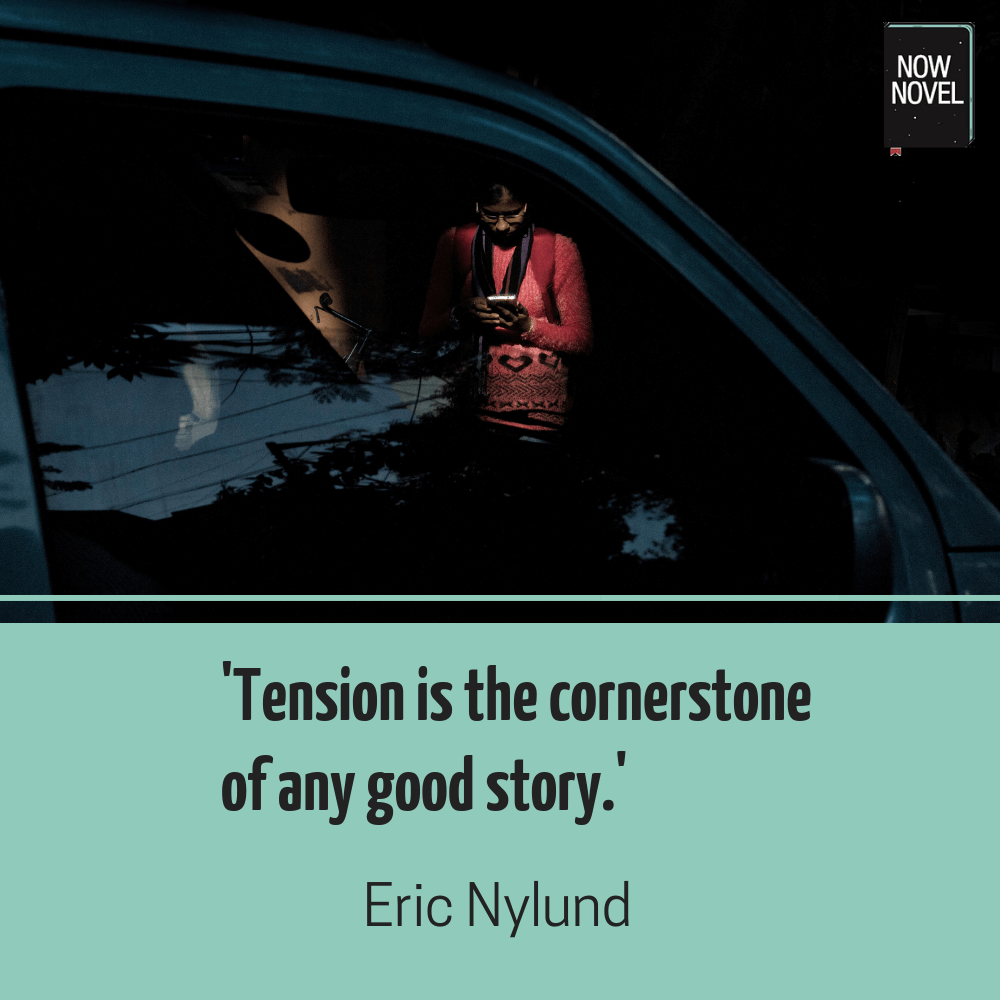Writing tense dialogue is effective in making characters’ conversations interesting. When every exchange is a pleasantry or obvious observation, dialogue doesn’t do the work it can to move a story along. Tense dialogue, whether an argument between colleagues, lovers, or hero and villain, adds a note of exciting unpredictability. Here are 5 ways to add tension to your dialogue:
1. Keep exchanges short and curt
When two characters are in a verbal sparring match, one may have the occasional, long-winded outburst. Yet keeping sentences (and barbs traded) shorter helps to keep a sense of friction in dialogue.
Consider this example from Deon Meyer’s crime novel, Cobra. Veteran cop Benny Griessel and his partner Vaughan Cupido are investigating a murder scene:
‘You’re sure you’re all right?’
‘I’m fine, Vaughn.’
‘Did you go home last night?’
‘No. According to the -‘
‘Was there a case I don’t know about?’
‘Vaughn, I worked late. You know how the admin piles up. And then I fell asleep.’ He hoped Cupido would just let it go.
‘In your office?’ Sceptical.
Effective dialogue is seldom all one length. Yet from this brief exchange, we see the prying questions of Griessel’s investigation partner, and how Cupido’s relentless questions chip away at the cop’s patience.
Meyer uses interruption to show how Cupido is like a dog with a bone, not letting go of his suspicion regarding why Griessel stayed at work late. Meyer keeps the men’s sentences short and terse. The effect is to add tension and a sense of the men’s cross purposes – Griessel’s determination to carry on with the investigation, and Cupido’s determination to know what’s going on with his partner.

2. Use contradiction
Contradiction in dialogue is one of the simplest tools to create tension. One person might say it looks like rain is coming, while the other retorts that the sky is perfectly clear. Small disagreements add up to show characters’ differences (of opinion, desire, mood).
Alice Munro is a master of showing the complexities and fractures in people’s private relationships. Her dialogue is often full of small, subtle conflicts between characters.
In the title story from her collection Runaway [read it here], Munro creates simmering tension between the couple Carla and Clark:
Carla called, “Do you want tea?” and to her surprise he got up and came into the kitchen.
“So,” he said. “So, Carla.”
“What?”
“So she phoned.”
“Who?”
“Her majesty. Queen Sylvia. She just got back.”
“I didn’t hear the car.”
“I didn’t ask you if you did.”
This small exchange about a woman whose home Carla cleans for money is loaded with tension. The small contradictions (‘I didn’t ask if you did’) add to this effect. We continue to read these contradictions on the following page:
She went into the living room with a brisk step and put her arms around him from behind. But as soon as she did that a wave of grief swallowed her up – it must have been the heat of the shower, loosening her tears – and she bent over him, all crumbling and crying.
He took his hands off the keyboard but sat still.
“Just don’t be made at me,” she said.
“I’m not mad. I hate when you’re like this, that’s all.”
“I’m like this because you’re mad.”
Throughout the couple’s dialogue, we sense their fundamental emotional difference. The contradictions between them create a sense of ongoing friction and tension around the smallest gestures and statements.
[Get feedback on a lengthy dialogue submission as part of our 4-week course, How to Write Dialogue. Learn more about our online writing courses here.]
3. Narrate tense actions mid-dialogue
Writing dialogue with tension also means involving characters’ entire bodies in the scene. When all we have are spoken words, the force and power of emotion must come from the words alone. Yet small gestures and actions – abrupt turns, sudden retreats – indicate the pitch tension has reached and how a character responds to this state.
Narrate actions such as someone turning their back, folding their arms, or even slamming a door. Consider this example from Toni Morrison’s Beloved. Sethe’s daughter Denver angers Sethe by inviting Paul D to stay the night:
“Why don’t you spend the night, Mr. Garner? You and Ma’am can talk about Sweet Home all night long.”
Sethe took two swift steps to the stove, but before she could yank Denver’s collar, the girl leaned forward and began to cry.
“What is the matter with you? I never knew you to behave this way.”
Here, Morrison briefly interrupts the flow of the dialogue with a description of Sethe’s sudden movement and her violent intent. It effectively shows how Denver’s speaking out of line creates tension between mother and daughter.
Find ways to use space and proximity between characters similarly to show passing moments of tension and conflict.
4. Use interruptions
Another method for adding tension in writing dialogue is to use interruption. When characters cut across each other, it clearly suggests that everyone is struggling to get a word in. This is particularly effective in multi-character scenes (for example, a town hall meeting that descends into chaos).
Consider this example from Zadie Smith’s White Teeth. Archie Jones’ boss Kevin Hero is making excuses for why Archie and his Jamaican-English wife were not invited to a company dinner:
‘…as I say, it’s not that I’m a racialist, Archie…’
‘A racialist…’
‘I’d spit on that Enoch Powell … but then again he does have a point, doesn’t he? There comes a point, a saturation point, and people begin to feel a bit uncomfortable … You see, all he was saying – ‘
‘Who?’
‘Powell, Archie, Powell – try and keep up – all he was saying is enough is enough after a certain point, isn’t it? I mean, it’s like Delhi in Euston every Monday morning.’
Through Archie’s interruption and Archie’s boss’ italicized ‘try and keep up’, we see the man’s irritation and the growing tension as he tries to spin a tale around his casual racism.
Archie’s interruption effectively breaks through the veneer of civility, and this break enables us to see the anger simmering beneath the boss’s prejudice.

5. Make the speaker’s tone tense
Tone is one of the simplest ways to add emphatic tension to a line of dialogue. If we read over the example by Zadie Smith above, the italics on ‘try and keep up’ create a sense of the character ‘snapping’. Italics immediately suggest a harshening of Kevin Hero’s voice, conveying his angry outburst.
There are several ways to convey tension through characters’ tone in dialogue. These include:
- Short, sharp, blunt questions: E.g. ‘What?’ or ‘Why?’
- Using imperative mood: Commands tend to sound angrier. For example, in Munro’s story, Clark says to Carla while she’s hugging him: “Don’t tell me what I am. You’re choking me. Start supper.”
- Describing the quality of a character’s voice: E.g. ‘His voice acquired a threatening tone. “Don’t tell me what I am”
In general, try to avoid dialogue tags using the combination ‘said’ plus an adverb ending ‘ly’ (e.g. ‘he said angrily’). These have a habit of drawing attention to themselves, and if overused take us out of the story. Toni Morrison’s advice for making dialogue sound soft applies:
“I never say ‘She says softly […] If it’s not already soft, you know, I have to leave a lot of space around it so a reader can hear that it’s soft.”
Similarly, leave less space around words that are meant to come across tense.
Need help improving your dialogue? Join Now Novel for constructive feedback from the community or your own personal writing coach when you upgrade.


2 replies on “Writing tense dialogue: 5 ways to add arresting tension”
Thank you so much for this it is gonna help with my novel.
It’s a pleasure, Abena. Good luck with it! Thank you for reading our blog.